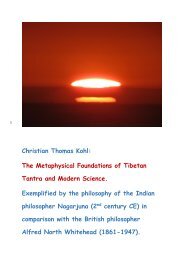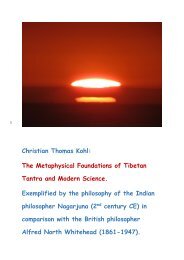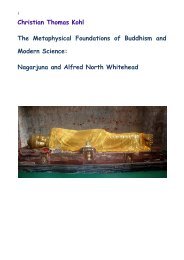The Metaphysical Foundation of Buddhism and Modern Science
The Metaphysical Foundations of Buddhism and Modern Science: Nagarjuna and Alfred North Whitehead
The Metaphysical Foundations of Buddhism and Modern Science: Nagarjuna and Alfred North Whitehead
You also want an ePaper? Increase the reach of your titles
YUMPU automatically turns print PDFs into web optimized ePapers that Google loves.
centimeter) <strong>and</strong> are so weak that they do not seem to play a role in holding<br />
anything together”. [20]<br />
In this respect, the explanations enter into quite difficult <strong>and</strong> subtle<br />
particulars. How, for example, can an electron which consists only <strong>of</strong> one<br />
particle be in interaction with another quantum object? What part <strong>of</strong> itself<br />
can it emit if it consists only <strong>of</strong> one particle? <strong>The</strong>se questions can be answered<br />
by the concept <strong>of</strong> interaction. In fact an electron does not exist <strong>of</strong> only a<br />
single particle exactly because the interaction <strong>of</strong> the electron is a part <strong>of</strong> it.<br />
In 1978 <strong>The</strong> physicists Daniel Z. Freedman <strong>and</strong> Pieter van Nieuwenhuizen wrote<br />
in this regard that “the observed electron mass is the sum <strong>of</strong> the 'bare mass'<br />
<strong>and</strong> the 'self-energy' resulting from the interaction <strong>of</strong> the electron with its<br />
own electromagnetic field. Only the sum <strong>of</strong> the two terms is observable”. [21]<br />
What in quantum physics is known about interactions is here summarized in the<br />
words <strong>of</strong> the physicist <strong>and</strong> Nobel prize laureate Gerard 't Ho<strong>of</strong>t: “An electron<br />
is surrounded by a cloud <strong>of</strong> virtual particles, which it continually emits <strong>and</strong><br />
absorbs. This cloud does not consist <strong>of</strong> photons only, but also <strong>of</strong> pairs <strong>of</strong><br />
charged particles, for example electrons <strong>and</strong> their anti-particles, the<br />
positrons. […] Even a quark is surrounded by a cloud <strong>of</strong> gluons <strong>and</strong> pairs <strong>of</strong><br />
quark <strong>and</strong> anti-quark”. [22]<br />
Singular, isolated, independent quarks, a phenomenon which is called<br />
‘confinement’ in recent research, have never been observed. Quarks are<br />
captives, they cannot appear on their own but only as one <strong>of</strong> a pair or as one <strong>of</strong><br />
a trio. When you try to separate two quarks by force, new quarks will appear<br />
between them which combine into pairs <strong>and</strong> trios. Claudio Rebbi <strong>and</strong> other<br />
physicists have reported that, “between the quarks <strong>and</strong> gluons inside an


















